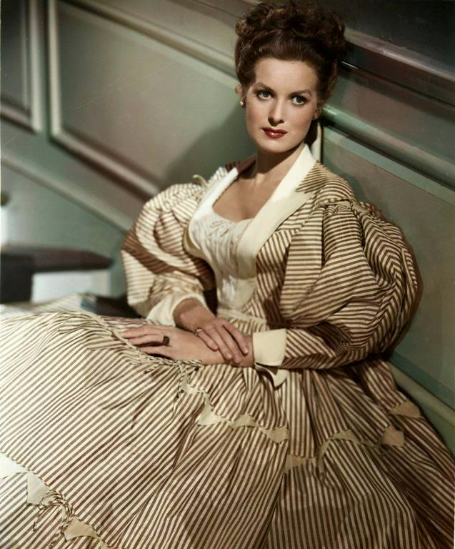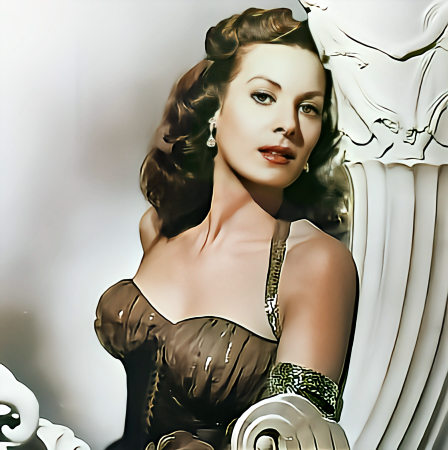Maureen O’Hara, born Maureen FitzSimons on August 17, 1920, in Dublin, Ireland, would become one of Hollywood’s most iconic actresses, earning the nickname “The Queen of Technicolor” for her striking red hair, green eyes, and porcelain skin that seemed made for the medium. Her remarkable six-decade career left an indelible mark on cinema history, embodying strong, passionate heroines who defied the conventional stereotypes of her era.

Early Life and Discovery
Born into a family that valued the arts, young Maureen showed early promise in acting, singing, and dancing. Her journey to stardom began when legendary actor Charles Laughton discovered her in London. Impressed by her natural talent and striking presence, Laughton helped secure her first major role in Alfred Hitchcock’s “Jamaica Inn” (1939), marking the beginning of an illustrious career.
Hollywood’s Fiery Star
O’Hara’s transition to Hollywood came at a pivotal time in cinema history. Her first American film, “The Hunchback of Notre Dame” (1939), opposite Charles Laughton, demonstrated her ability to hold her own against established stars. However, it was her role in John Ford’s “How Green Was My Valley” (1941) that truly established her as a leading lady of substance.
The actress became known for her ability to portray strong-willed, independent women who weren’t afraid to stand their ground. This was particularly evident in her collaborations with John Wayne, with whom she starred in five films, including the beloved classic “The Quiet Man” (1952). Their on-screen chemistry was legendary, creating some of cinema’s most memorable moments.
Versatility and Range
While O’Hara is often remembered for her dramatic roles and Westerns, her versatility as an actress was remarkable. She demonstrated her comedic timing in films like “Sitting Pretty” (1948) and showed her softer side in the holiday classic “Miracle on 34th Street” (1947). Her performance range extended to swashbuckling adventures, where she often performed her own stunts, setting her apart from many actresses of her time.

Beyond Acting
O’Hara’s achievements extended beyond the silver screen. She became the first female president of a scheduled airline when she took over Antilles Air Boats after her husband’s death. This demonstrated her business acumen and pioneering spirit in an era when women rarely held such positions.
Legacy and Recognition
Despite her numerous memorable performances, O’Hara was never nominated for a competitive Academy Award during her active years. However, in 2014, at the age of 94, she was finally honored with an honorary Oscar at the Governors Awards, recognizing her lifetime of contributions to cinema. The award celebrated her “passionate, warmth and strength” that characterized her performances throughout her career.
Personal Life and Character
Known for her straightforward personality and professionalism, O’Hara earned respect throughout the industry. She was proud of her Irish heritage and maintained strong connections to her homeland throughout her life. Her autobiography “‘Tis Herself” revealed her determination to succeed on her own terms in an often-challenging industry.
Impact on Cinema
O’Hara appeared in over 50 films during her career, many of which are considered classics today. Her work in Technicolor films helped establish the format’s popularity, as her natural coloring and screen presence showcased the technology’s capabilities perfectly. She set a standard for female actors in adventure films and Westerns, proving that women could be both feminine and formidable.
Cultural Influence
Beyond her film work, O’Hara’s influence on popular culture was significant. She challenged stereotypes about female actors, refusing to be merely decorative and insisting on roles that had substance and strength. Her portrayal of independent, capable women helped pave the way for more complex female characters in cinema.
Later Years and Honors
In addition to her Oscar, O’Hara received numerous accolades throughout her career, including the Heritage Award from the American Ireland Fund in 1991. She officially retired from acting in 2000 with “The Last Dance,” where, even at 80, she demonstrated the grace and screen presence that had characterized her entire career.
Final Legacy
Maureen O’Hara passed away on October 24, 2015, leaving behind a legacy that continues to influence cinema and popular culture. Her contributions to film extended beyond her performances – she helped change perceptions about what women could achieve both on and off screen. Her work remains relevant today, with new generations discovering her films and appreciating her pioneering spirit.
Her remarkable career spanned from the golden age of Hollywood through the transformation of the industry in the latter half of the 20th century. O’Hara’s ability to adapt and thrive through these changes while maintaining her integrity and principles makes her story particularly inspiring.
Today, Maureen O’Hara is remembered not just for her stunning beauty or her memorable performances, but for her pioneering spirit, professionalism, and determination to succeed on her own terms. Her legacy continues to inspire actors and filmmakers, reminding us that true star power comes not just from physical beauty, but from strength of character, dedication to craft, and the courage to challenge conventions.
